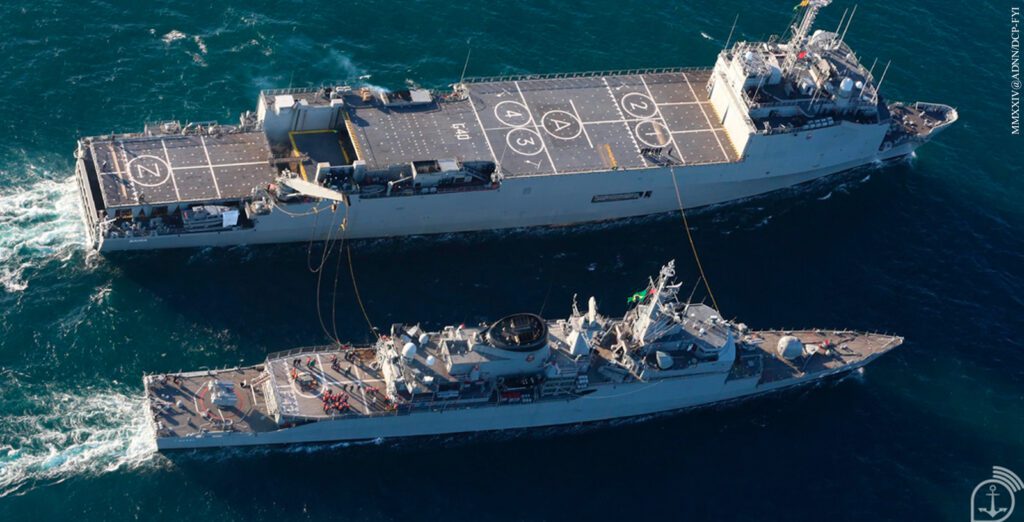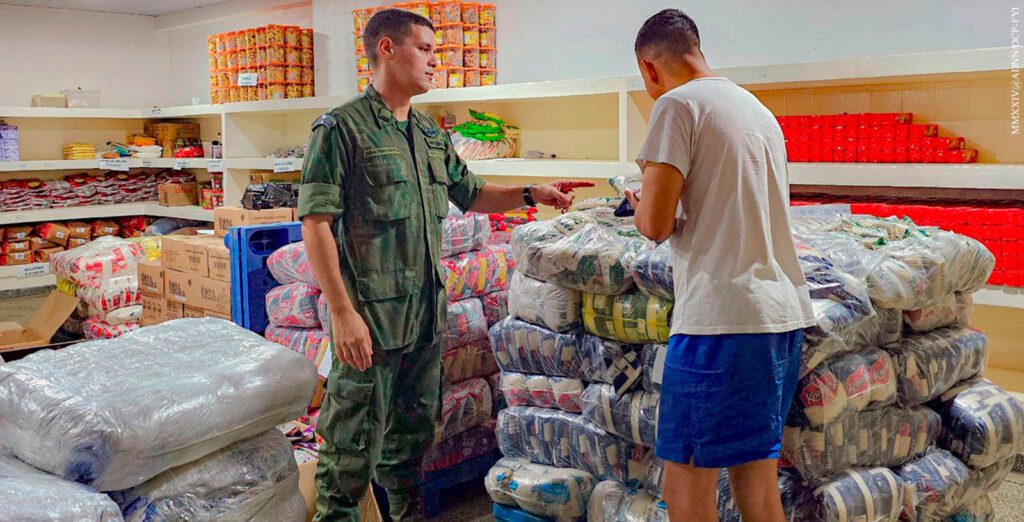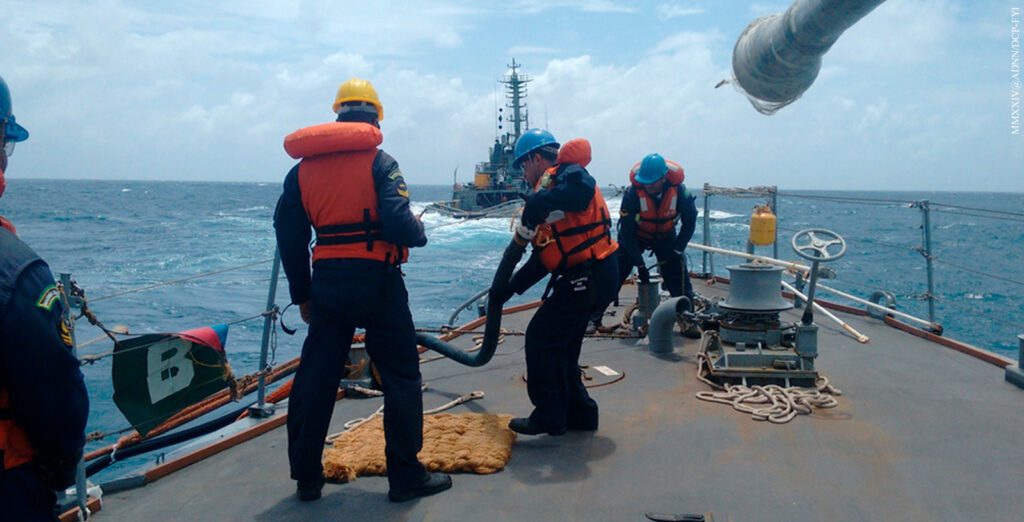Navy Intendance celebrates 254 years of creation on March 3rd
By First Lieutenant (T) Ohana Gonçalves – Rio de Janeiro, RJ
To protect the riches of the Blue Amazon, Brazilian Navy (MB) ships are strategically positioned in all regions of the country. When on mission, they spend days sailing self-sufficiently (without the need to refuel in ports) in order to carry out Naval Patrol and Inspection actions, as well as various exercises to increase the capabilities of the Brazilian Naval Power. MB amphibious troops operate in places that are difficult to access, such as jungles and isolated riverside communities, to train in adverse conditions or collaborate in actions in support of the State, often with no plans to return home. Behind all this, there is a job that few people know about, but which is essential: “forecasting and providing”, carried out by the Navy’s Intendence, which this year celebrates its 25th anniversary.
Following the evolution of various fields of knowledge, the MB’s Intendency works in the areas of supply, administration, accounting, internal control, economics, finance and real estate management. Navy Intendants (IM) work on board Fleet and District ships and the Directorate of Hydrography and Navigation; as well as Military Organizations (OM) of the Marine Corps, Bases and Naval Hospitals, among others. They also play a technical or management role in OMs, typical of areas such as administration and supply.
“Recent events on the international stage show that a nation of continental size must have modern, well-sized and ready Armed Forces. In this way, the Intendencia must be ready and able to respond in a timely manner to new and unexpected demands from our Naval Force. To this end, I urge you to follow the ideals and examples of our predecessors; to persevere in promoting solid ethical and moral values; to cultivate the virtues of purity and honesty symbolized by the Acanthus Leaf that you proudly wear on your uniforms; and to keep naval traditions in their minds and love for the Brazilian Navy in their hearts,” urged Vice-Admiral (IM) Luiz Roberto Basso, the Navy’s Supply Director, at a ceremony to commemorate Navy Endowment Day, held last Friday, March 1.
Intendancy at sea
The Multipurpose Aerodrome Ship (NAM) “Atlântico”, the largest ship in the Brazilian Fleet, holds up to 1,100 people on board. Second Lieutenant (IM) Gabriela Gomes de França Arouca, from the Naval School (EN), is part of the crew of the “Atlântico”, where she works as a Pay Agent. “This role requires greater knowledge of the rules governing the payment of military personnel and, consequently, the execution of payment. My assistant and I manage around 500 of the crew’s financial records every month.” She is also the Division Manager and Liaison Officer for the Neptune Programme, which aims to institutionalize good management practices, enabling the continuous improvement of processes inherent to her activity.
As munitions manager, Second Lieutenant (IM) Gabriela França managed the Division with the support of 40 military personnel, divided between the specialties of cook, valet and paioleiro. She says that the activities require dedication, due to the high consumption of food. “On a routine voyage, around 4,000 meals are prepared every day, catering for the entire crew. I controlled everything from the stock of materials to be consumed to the preparation of the menu and meals, in other words, the entire supply chain.”
Regarding the biggest challenge she has ever faced, the lieutenant highlights the “Shelter by Sea” mission in February 2023, which lasted around two weeks and began during the Carnival holiday, in order to support the city of São Sebastião (SP), which suffered from major natural disasters caused by heavy rains.
“The ship had to be prepared to undock in 24 hours. I had to rely on the dedication and support of various agents involved, from the Navy Supply sector, the Navy Intendency Supply Depot, to the suppliers of the tenders in force during the period, who responded promptly to supply approximately 10 tons of foodstuffs in 24 hours.
This experience brought me both professional and personal fulfillment. Intendance acts as a crucial part of a large machinery that supports the Navy’s core business, with a view, above all, to ensuring the readiness of operational assets. I recognize that it was a time of great professional maturity, in which I established priorities and goals to be met in the short term, making part of the ship’s supplies for the mission possible,” recalls the lieutenant.
Excited, Lieutenant Gabriela França doesn’t hide her satisfaction with her chosen career: “I have the opportunity to work not only in the operational sector, but in various other areas of the Navy that add value to my technical and professional skills. The Navy Lieutenant Corps is characterized by its capillarity in order to serve and support the MB in any sector and this is a source of pride. We are part of the preparation for major missions. I’m sure that wherever I am, I’ll be wearing my Acanthus leaf (symbol of the Corps) and I’ll be providing the best service to the Force.”

Intendencia in the Amazon jungle
After serving seven years as a temporary officer in the Brazilian Army, Jonathan Matos de Faria took part in a public examination to join the Navy’s Complementary Board of Intendant Officers (QC-IM), winning the vacancy in 2021. “I studied business administration with the dream of administering and managing resources. In the Intendencia, I found this goal and, in the Navy, an environment that has values and responsibility for transparency.”
Currently, Second Lieutenant (QC-IM) Jonathan Matos works with the Marine Corps as Paymaster, Material Manager and Neptune Program Manager at the 1st Riverine Operations Battalion (1ºBtlOpRib), in Manaus (AM). When he started serving in the Western Amazon, one of his concerns was logistics in a location that was difficult to access, especially with regard to support for feeding the troops; the need for materials; and even pay. Previously, he also held the position of munitions manager.
“In almost two years, I was able to experience various aspects of the Intendencia. At the ranch [the place where meals are prepared and served], there are several concerns, among them: the management and acquisition of foodstuffs, stock and daily consumption. You also have to deal with personnel management. There are almost 30 military personnel to coordinate. As for payment, procurement, financial execution and material, we have to comply with the rules and specifics of each of these functions,” he explains.
To familiarize himself with the activities of the Brazilian Marine Corps, Lieutenant Jonathan Matos took the five-week Expedited Riverine Operations Course. He participated intensively in activities such as abseiling, jungle survival, first aid, communications, utility swimming, navigation and platoon planning. “Of all the challenges I’ve faced, this was certainly one of the biggest in my life. I successfully completed the course, becoming the Navy’s first Intendant Riverine Operator,” he says proudly.

Origin of the Navy
The Intendência da Marinha began in Brazil’s colonial period, when King José I of Portugal implemented measures to improve the royal collection and inspection of taxes, as well as professionalizing the management of public accounts. In 1770, a royal charter created the position of Intendente da Marinha e Armazéns Reais (Intendant of the Navy and Royal Warehouses) to work initially at the Bahia Navy Arsenal. The results were so expressive that, as a result, the position was extended to the other naval arsenals in the colony’s captaincies.
With the arrival of the Royal Family in Brazil, the Rio de Janeiro Navy Arsenal, renamed the “Court Arsenal”, was given control of the financial resources and supplies for all the land-based organizations and ships. In 1808, Prince Regent João VI created the Contadoria da Marinha at the Arsenal da Corte, which began to concentrate the entire logistical, financial and personnel payment apparatus of the Secretariat of State for the Affairs of the Navy. After numerous decrees and laws, in the post-war context, in 1952, the Navy’s Directorate of Intendance was created in order to act in the areas of accounting, finance, economics, supply, administration and auditing.
The activation of the Directorate was the result of a study conducted by Vice-Admiral (IM) Gastão Motta, Patron of the Navy’s Corps of Intendants, who restructured the Intendancy service along the lines of the US Navy, adapted to the reality of the Brazilian Naval Force. The analysis also made it possible to adopt new measures, among them: the creation of material stock control centers; naval supply centers; primary and secondary stock depots distributed throughout the naval districts; continental and overseas purchasing offices; a uniform factory; and an instruction center.

How do I become an Officer of the Brazilian Navy?
Officers in the Corps of Intendants are graduates of the Naval School or are admitted with a degree in Economics, Administration or Accounting to the Navy’s Complementary Board of Intendant Officers (QC-IM), with the possibility of rising to the rank of Vice-Admiral.
The call for tenders for the QC-IM is expected to be published in the second half of March this year. For the Naval School, it should be published in April.
The benefits of a naval career include: the prospect of professional growth throughout one’s career; a good working environment; a well-defined career plan, with the possibility of continuous advancement with proportional salary increases; and stability after five years of service, among others.
Source: Agência Marinha de Notícias *** Translated by DEFCONPress FYI Team ***
